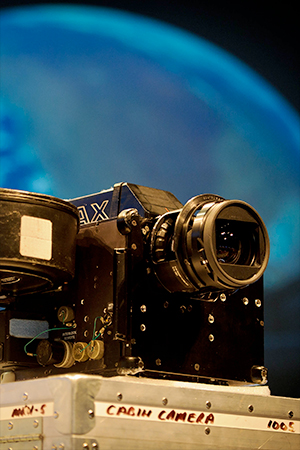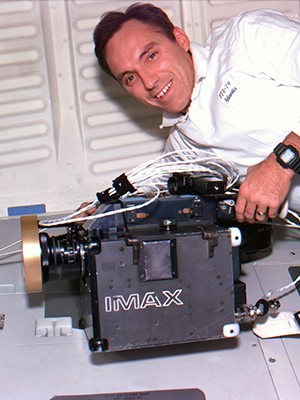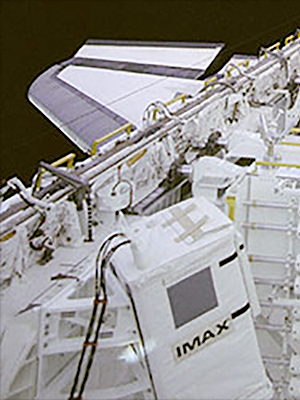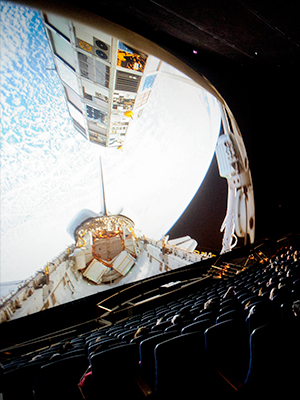April 4, 2012 — Two large-format motion picture cameras that gave the public the opportunity to see and experience what astronauts saw flying on board the space shuttle are now part of the Smithsonian's collection.
On Wednesday (April 4), the IMAX Corporation donated its two space-flown two-dimensional cameras to the National Air and Space Museum in Washington, DC. The cameras, which captured the scenes for six IMAX movies including "The Dream is Alive," "Blue Planet," and "Mission to Mir," were carried aboard 17 shuttle missions between 1984 and 1998.
"Receiving this donation of flown-in-space cameras from IMAX brings a story from the museum's history full circle." said Jennifer Levasseur, museum specialist in the division of space history. "The museum partnered with IMAX and Lockheed Martin in 1983 to create early space films such as 'The Dream Is Alive' to increase public understanding of spaceflight through large-format films."
"Now, the museum will preserve and soon display these cameras to educate and inspire future generations," said Levausser in a statement.
The National Air and Space Museum hosted a screening of the 1985 movie, "The Dream is Alive," on Wednesday, followed by a donation ceremony with the IMAX cameras' co-inventor Graeme Ferguson, director and producer Toni Myers, and former astronaut cameraman Bill Readdy.
Myers, who headed all of IMAX's space films, including the two recent three-dimensional movies "Space Station 3D" and "Hubble 3D," said the the 2D cameras represent a "unique little chunk of spaceflight history."
"I say unique as I think it is pretty special that something like that could happen, whereby we could actually go train astronauts to be our ambassadors here on Earth to go into zero gravity and space and take us where we couldn't go," Myers told collectSPACE.com in an interview.
Max and Icky-Bicky
The two donated cameras filmed both interior and exterior scenes in space, flying in different areas of the orbiters.
"IMAX donated to us all of the equipment that they had maintained rights to after they flew on the space shuttle," Levasseur told collectSPACE. "The primary IMAX pieces are the cameras themselves: the two dimensional in-cabin camera that the astronaut crews operated by hand and the payload bay camera that was operated by the astronauts remotely. It was always situated in the payload bay of the shuttle."
The in-cabin camera will be placed in the shuttle-devoted "Moving Beyond Earth" gallery, inside a full-scale mockup of the orbiters' crew compartment's mid-deck.
The cargo bay camera will be exhibited alongside the soon to arrive space shuttle Discovery at the museum's Steven F. Udvar-Hazy Center in northern Virginia.
"There's a camera in a case out there that is coming out for display in another exhibit and I'm hoping the payload bay camera can just take its place in that display case," Levasseur said.
Both of the cameras have nicknames that were given to them during their 14 years of spaceflight service.
"The cabin camera was called 'Max,'" Myers recalled. "I've forgotten who first called it Max but they said it was like having a great big dog along on a mission. Its presence was there. Some crews started calling it Max and it just stuck."
"The IMAX cargo bay camera, its acronym ICBC, became known as 'Icky-Bicky,' just from reading it off the page," Myers said.
Focal point for the shuttle era
It is not a coincidence that the camera donation coincided with the end of the shuttle program. Although IMAX has gone on to use 3D cameras, it was the completion last year of the 30 year NASA program that drove the timing of the cameras' accession into the national collection.
"Because they were partners in the making of these films that documented the early shuttle era, it just seemed to make sense to everyone that it be a part of the exhibit," Myers said, referring in part to the April 17 arrival of space shuttle Discovery. "It was not just us deciding they could have the cameras. It just seemed like absolutely the right thing to do."
According to Levasseur, the scenes that the two cameras captured brought the shuttle program into focus.
"Looking back on the Apollo [moon landing] program, the Hasselblad camera is 'the' camera, the focal point for the photography and the way in which we understand images of that era. I think the IMAX camera holds a similar place in the shuttle era," Levasseur said.
"I think it is much more difficult for people to identify still photographs from particular shuttle missions as there were so many more missions and so many more astronauts involved," she added. "I think the IMAX films are actually probably one of the focal points for how people understand the space shuttle era. They are so big and they have so much impact on you, almost physically, when sitting in an IMAX theater."
As such, according to Levasseur, the cameras are "really key pieces" for the museum, especially in the context of the last 30 years of human spaceflight.
History and future of IMAX in space
The cameras are also a natural fit given that idea of flying IMAX cameras into space was originally proposed by the museum's first director, Apollo astronaut Michael Collins.
"When the IMAX projection system and the theater were to be installed in the Air and Space Museum in the early 70s and Mike Collins, having been an Apollo astronaut, saw the effect IMAX had on the audience and on him, he said, 'These cameras have to fly in space because this is the only way you get a real idea of what our experience is as astronauts,'" Myers said, paraphrasing Collins.
"From the day he said that, it took Graeme Ferguson and all the people working together to make it happen 10 years before it was actually a reality."
For Myers, Collins' original dream is still very much alive, even if the cameras are no longer flying.
"Certainly, if I have anything to do with it, it is not the end of IMAX space movies," Myers said. "For the moment we cannot fly IMAX film back and forth to space because there is no transport for it. Until we have a transportation system on a regular basis going back to the station, we can't fly IMAX film because it can get radiated if it stays there a long time."
"But digital cameras, and IMAX now has a digital camera, have improved and are improving by leaps and bounds so rapidly. So I have no intention of stopping trying to make space films. They just will not be filmed on 65 millimeter negatives any more." she said.
"So no, it's not the end of space films, not at all. I have one that I am planning and hoping to do. I'm just trying to raise the money for it now," Myers added. "It is about our future on and off the planet." |
|

An IMAX camera that flew aboard the space shuttle is seen at the Smithsonian's National Air and Space Museum. (NASA/Paul Alers)

Astronaut Carl Walz handles the IMAX in-cabin camera during the STS-79 mission aboard space shuttle Atlantis in 1996. (NASA)

The IMAX Cargo Bay Camera (ICBC) can be seen in space shuttle Atlantis' payload bay during the 1985 STS-61B mission. (NASA)

Spectators watch the movie "The Dream is Alive" in the National Air and Space Museum's Lockheed Martin IMAX Theater. (NASA) |
